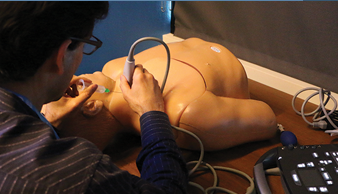Critical Care Ultrasonography: Integration Into Clinical Practice
By: Ariel L. Shiloh, MD
September 19, 2017
My introduction to ultrasonography was as a fellow in critical care medicine. Luckily, my training program was an early adopter in point of care ultrasonography. An ultrasound machine was available, but the attending training was varied and, at often times, limited. The fundamentals of image acquisition and recognition were presented at the beginning of the training, but ultrasound was mostly seen as a tool to assist with central venous access.
Ultimately, with persistent use, self-learning, and close mentorship from other early adopters, ultrasonography became an essential tool for the evaluation of critically ill patients. With time, there was more “buy in” from senior faculty, and our use of goal-directed ultrasound became more widespread, but there was no protocolled approach to evaluating a patient.
At our institution, the Critical Care Consult Service, sometimes known as the “ICU without Walls,” evaluates over 10,000 patients yearly throughout the medical and surgical wards, ED, and postoperative units, in addition to providing senior leadership for rapid response teams and cardiac arrests. Point of care ultrasonography has become an indispensable tool.
 Pulmonary edema or pulmonary embolism? Effusion or pneumonia? Heart failure or septic shock? Volume up or volume down? What to do next in a cardiac arrest? These are just some of the questions we are faced with during emergencies. Our fellows follow a systematic and protocolled approach to the critically ill patient. Every consultation includes a point of care ultrasound. Patients in shock or respiratory failure receive focused algorithmic cardiac, thoracic, and vascular exams. Blood loss anemia and trauma triggers an eFAST exam. Renal failure leads to a renal and bladder evaluation. Our portable ultrasounds have become an essential tool for evaluating patients, allowing us to appropriately focus timely therapies without having to dangerously transport patients for diagnostic tests.
Pulmonary edema or pulmonary embolism? Effusion or pneumonia? Heart failure or septic shock? Volume up or volume down? What to do next in a cardiac arrest? These are just some of the questions we are faced with during emergencies. Our fellows follow a systematic and protocolled approach to the critically ill patient. Every consultation includes a point of care ultrasound. Patients in shock or respiratory failure receive focused algorithmic cardiac, thoracic, and vascular exams. Blood loss anemia and trauma triggers an eFAST exam. Renal failure leads to a renal and bladder evaluation. Our portable ultrasounds have become an essential tool for evaluating patients, allowing us to appropriately focus timely therapies without having to dangerously transport patients for diagnostic tests.
CHEST’s Critical Care Ultrasonography: Integration Into Clinical Practice is a unique live learning course intended to take fundamental ultrasound skills to the next level. Case-based learning using real-life imaging and whole body ultrasound demonstrates methodical, protocolled approaches to: hemodynamic instability and shock states, acute respiratory failure and dyspnea, acute renal failure, venous thromboembolic disease, abdominal catastrophes, and cardiac arrest. Additionally, ultrasound-guided procedures skills are enhanced using vascular, pleural, and peritoneal simulators.
The course is taught by an exceptional group of physician educators and leaders in the field of point of care ultrasonography. Critical Care Ultrasonography: Integration Into Clinical Practice is intended to take any physician, advanced practice practitioner, or student with a baseline understanding in image acquisition and interpretation to the next level.
Learn more about Critical Care Ultrasonography: Integration Into Clinical Practice, November 10-12, held at CHEST.
Dr. Shiloh works in critical care medicine and is the Director of both Critical Care Consult Service and Critical Care Ultrasonography, and the Associate Professor of Medicine and Neurology at the Montefiore Medical Center of Albert Einstein College of Medicine in Bronx, NY.